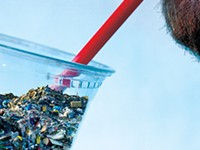[
{
"name": "500x250 Ad",
"insertPoint": "5",
"component": "15667920",
"parentWrapperClass": "",
"requiredCountToDisplay": "1"
}
]
Consumers have an insatiable appetite for electronic devices, whether it's the powerful smartphones in their pockets, the massive television screens on their walls, or the sleek laptops they carry with them.
The electronics industry understands that appetite well, and it's constantly churning out new products to render the old ones obsolete. And every time a new phone, TV, or computer is purchased, it replaces an old one, which has to go somewhere.
There was a time when many consumers just threw their old electronics in the garbage. Those days, however, are gone: an electronics disposal ban contained in the state's 2010 e-waste law took effect earlier this year. New Yorkers can no longer legally put their unwanted electronics out to the curb; they have to find a place to recycle those devices, which include old computers, video games consoles, and televisions. (Cell phone disposal and recycling is actually addressed under a different law.)
The disposal ban was the final part of New York's e-waste law to take effect, and it remains to be seen whether it'll boost electronics recycling in the state. That's not because the disposal bans are ineffective - e-recycling advocates say they're crucial for keeping electronics out of landfills - but because New York's e-waste law has already been very successful.
"We've seen a tremendous increase in consumer electronics recycling," says Mike Whyte, president of Regional Computer Recycling and Recovery in Victor.
The 2010 law helped bring e-waste issues to the public's attention, he says. And the amount of electronics collected for recycling really grew after commercial trash haulers were banned from accepting recyclable e-waste, he says. That happened under a provision that took effect in 2012.
At Monroe County's Ecopark, where the public can drop off electronics for recycling, collections grew to 409,449 pounds last year, up from 324,214 pounds in 2012, says Nicole Fornof, a spokesperson for Waste Management of New York, which operates the facility for the county. As of last week, Ecopark had collected 273,989 pounds of electronics in 2015, Fornof says.
Sunnking, a Brockport-based recycler, takes in the electronics from Ecopark and from many other drop-off sites across the region and state. In recent years, it's consistently collected about 24 million pounds of e-waste, say company officials.
And statewide, e-waste collections increased from 44.8 million pounds in 2011 to 99.5 million pounds in 2013, according to the state Department of Environmental Conservation. The department is still calculating 2014 figures, but says they'll be available soon.
"What the law has been very effective at doing is developing a collection network," says Dawn Timm, an environmental engineer for Niagara County and vice chair of the New York Product Stewardship Council. The council advocates for laws that require manufacturers of certain products - paint and electronics are two examples - to pay for collecting them and either recycling or disposing of them.
But some problems have developed around the state's e-waste law. The New York Product Stewardship Council developed proposals to address those issues, which it hoped state lawmakers would take up this session. But since the legislature adjourned last week, the council is now looking to 2016 for the fixes.
The main issue with the e-waste law is how it funds collection initiatives and events, Timm says. And the problem is largely related to certain pervasive, hard-to-recycle items, namely cathode ray tube (CRT) televisions and monitors.
The state's e-waste law requires electronics manufacturers to take back their own products for recycling, free of cost to the consumer. But it also requires them to fund e-waste and recycling efforts across the state. The amount each company must spend depends on how many pounds of electronics it sold during the previous year.
The whole idea of that requirement is to give New Yorkers a convenient and inexpensive way to recycle electronics. And many local governments have partnered with recyclers to organize collection initiatives and events.
"We know there's a demand for responsible electronics disposal in the community, so we want to provide a centralized point," says Mike Garland, director of Monroe County's environmental services department.
For the most part, the arrangement works well. Recyclers are able to take most of the collected electronics, from old Betamax VCR's to well-worn iPads, and make some money off of them. Some recyclers will refurbish and resell items; others will dismantle them and pull out valuable materials or components, which they'll sell.
When that happens, they don't charge the governments anything. The Town of Brighton, which holds two e-waste collection events a year, usually makes a few hundred dollars, says Supervisor Bill Moehle. The primary reason it holds the events, however, is to help keep electronics out of landfills, he says.
"We do it as a service to our residents, and our residents love it," Moehle says.
But CRT televisions and monitors change the dynamic, especially since New Yorkers can no longer haul them out of the basements or garages and onto the curb without getting fined. The tubes inside of the old displays are loaded with lead and other toxic materials, and they require a lot of processing. They also yield little valuable scrap.
Recyclers have started charging to take the CRT's in, and there's not enough electronics industry money to cover those costs, Timm says. As a result, two things happen. Many electronics drop-off locations won't take the televisions anymore, or the places that collect them start charging a fee. Ecopark, for example, charges $10 per CRT television or monitor. And it does so because Sunnking charges the county for each of the items collected, Garland says.
The New York Product Stewardship Council sees a simple way to work through the CRT problem, and it centers on the formula for determining a manufacturer's e-waste funding obligation. Lawmakers should suspend the current formula for two years, and require the industry to provide enough funding for each New Yorker to recycle five pounds of electronics. That, combined with some other technical fixes, would generate more funding for free collection programs, Timm says.
"It's about convenience and consistency," she says.
Speaking of...
-

It's a plastic planet
Apr 18, 2018 -

Finding common ground: for Earth Day, bridging our national divide
Apr 5, 2017 -

Tired out
Apr 29, 2015 - More »
Latest in News
More by Jeremy Moule
-

ROCHESTER TEN
ANNETTE RAMOSAug 1, 2023 - More »






